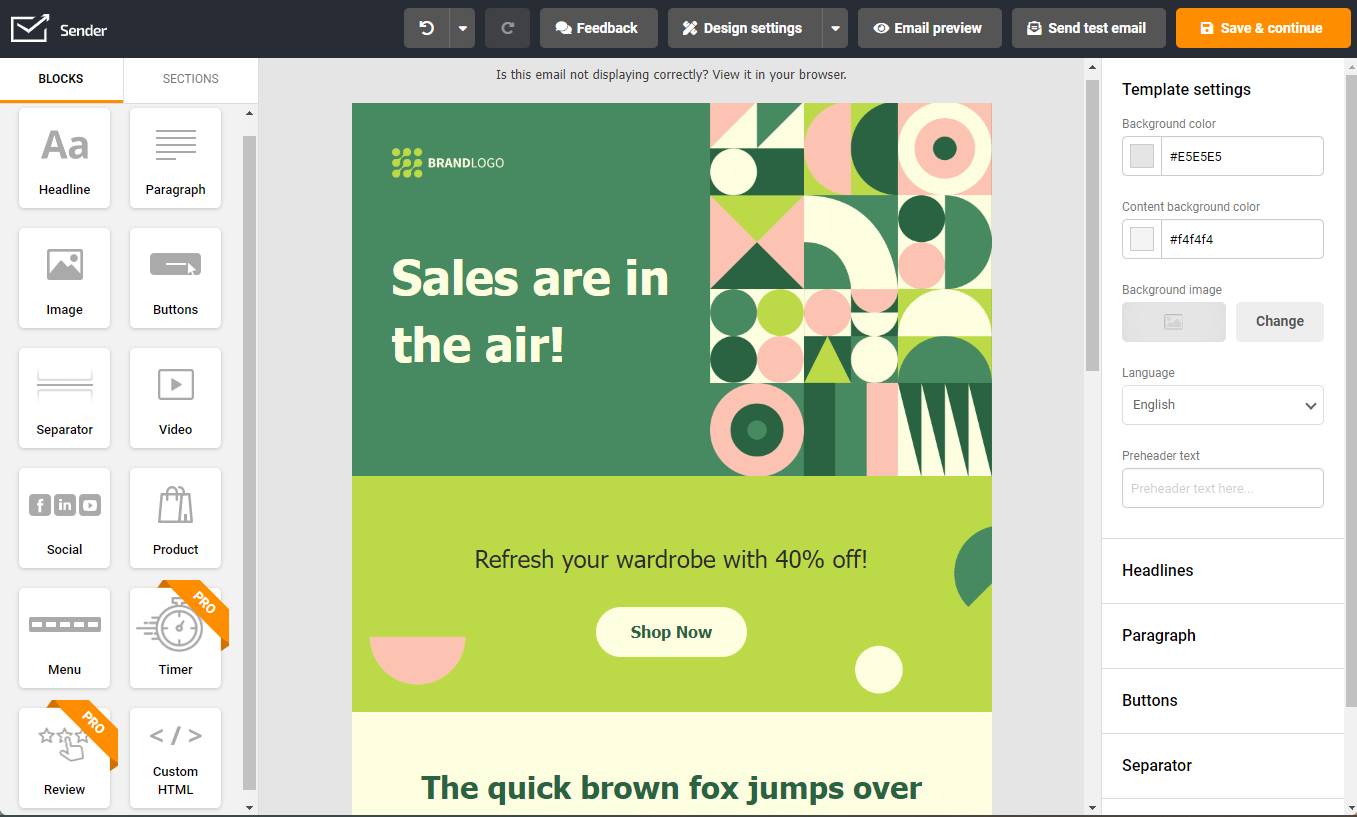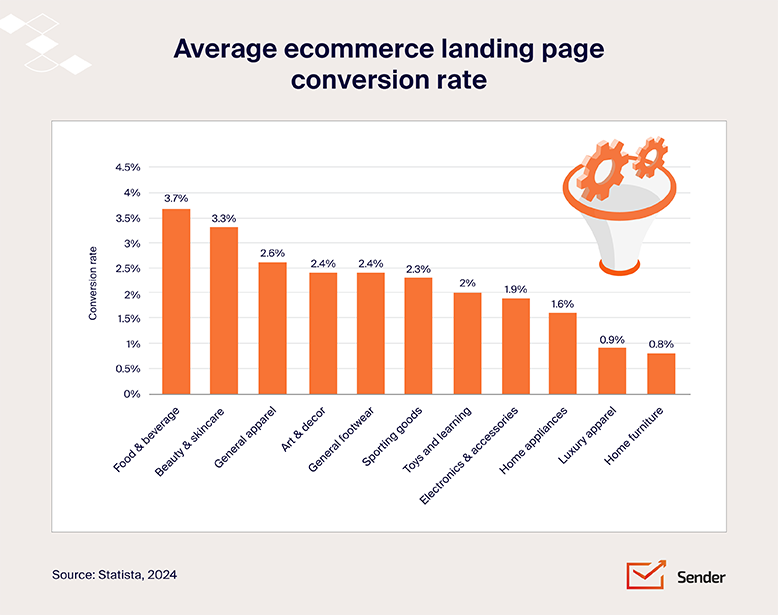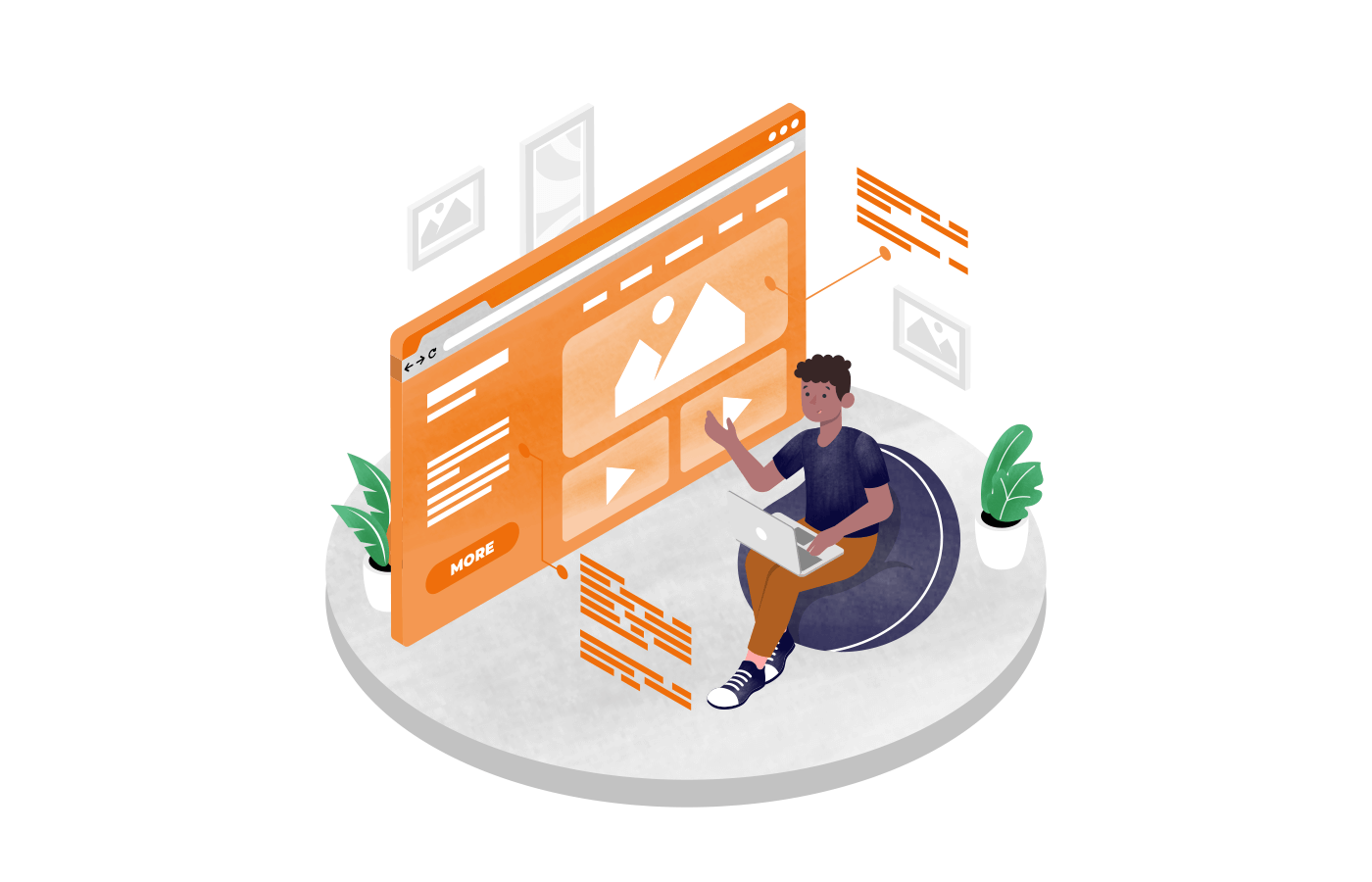Let’s be honest, you’re pouring your heart and soul into your campaigns, driving traffic to your landing pages. But are they actually converting?
A well-optimized landing page can make all the difference. It’s the key to turning those visitors into leads and customers.
We’re talking about real results – like a 202% boost in conversions just by personalizing your call-to-action!
Ready to see those numbers climb? Here you’ll find some landing page optimization best practices and tips. They’re taken from real landing page optimization case studies, so you know that they actually work!
But first, let’s look at the basics – what is landing page optimization?
What is Landing Page Optimization?
Your landing page needs to do more than just look pretty. It needs to get people to take action. Whether that’s signing up for your newsletter, downloading a lead magnet, or buying your product, your landing page is your chance to convert visitors into customers.
A “bounce” happens when someone leaves your page without taking action. That’s bad news, especially if you’re paying for traffic. That’s where landing page optimization comes in.
Landing page optimization techniques help you fine-tune your website landing page to engage your target market audience better. By improving the visuals, text, and overall message, you can:
- increase the number of leads;
- improve lead quality;
- boost registrations;
- ultimately optimize your conversion rate.
Check out these 15 best practices for email marketing lead generation to see which one suits your business best.
Why Landing Page Optimization Matters
Wondering what sets other landing pages with impressive conversion rates apart from yours? Well, the secret is regular optimization. But don’t worry, it’s easier than you think!
To optimize your landing pages, you don’t need to break the bank or navigate complex landing page optimization services. With a few landing page optimization tips and simple tweaks, you can fast-track your visitors through the sales funnel.
The best part? You won’t need any expensive or complicated optimization tools. Just a good understanding of what works and a straightforward approach can make a significant difference in no time. This leads to:
- Enhanced landing page experience. Your visitors will enjoy a smoother, more enjoyable time on your landing page thanks to better, well-structured, and relevant content;
- Landing page conversion optimization. Regularly optimizing your landing pages can lead to conversion rate improvements, whether in lead generation or ecommerce sales from your website traffic;
- Lower customer acquisition costs. Optimized landing pages lead to better user experience and deliver more value to your targeted visitors, leading to lower cost-per-click (CPC) and reduced overall customer acquisition costs (CAC).
Important Landing Page Elements
More often than not, a landing page follows a traditional structure with the following elements, each with its own purpose and benefits:
- Headline capturing attention and conveying the main benefit or purpose of the page;
- Subheadline providing additional information or context to support the headline;
- Call-to-action (CTA), a prominent button or link that guides users towards the desired action (e.g., “Sign Up”, “Buy Now”);
- Hero image or video, a visually engaging element that illustrates the product or service and grabs attention;
- Social proof: testimonials, reviews, case studies, or logos of well-known clients to build trust and credibility;
- Benefits and features in a list or section detailing the key benefits and features of the product or service;
- Form for capturing user information (e.g., for lead generation);
- Trust indicators like security badges, guarantees, or certifications reassure users about their safety and the legitimacy of the offering.
Best Practices for Landing Page Optimization and Strategies
Trying every recommendation and best practice available online is a sure-shot way to doom your conversions. So, instead, ensure that the below fundamentals of optimizing landing pages are in place before considering anything else.
Also read: Landing Page Best Practices to Follow in 2024
Complete Pre-Work to Have High-Converting Landing Page
Pre-work is what you must have already done before strategizing that landing page for Facebook or Google ads (PPC) campaigns. So, let’s revisit these fundamentals anyway.
- Solid audience research. You should already have your Buyer Personas (Customer Avatars) in place and be aware of your prospects’ likes and dislikes, fears and frustrations, and ambitions and aspirations;
- Understand your own business. You must have a clear idea about how your business helps your target audience. What pain points does it solve? How it’s so much better than the competition (i.e., USP or Unique selling point)?
- Clear business objectives. You must know your overall business goals and how this current campaign is aligned with those goals;
- Google Analytics integration. Having Google Analytics set up and integrated is crucial for tracking website traffic, user behavior, and campaign performance.
Also read: 12 High Converting Landing Pages Examples & How to Build One
Make Sure Your Campaign has a Singular Focus
Before you dive into landing page optimization, take a moment to clarify your goals. What’s the single, most important action you want visitors to take?
Ask yourself:
- Why are they on your page? What are their needs and pain points?
- What do they already know about your brand and product?
- Are you aiming for more leads, sign-ups, or sales?
Remember, your landing page should have a laser focus. Avoid overwhelming visitors with too many options.
For example, if you want people to download an ebook, create a dedicated landing page for that purpose. Don’t try to promote both an ebook and a webinar on the same page.
And if you have multiple customer segments, tailor your landing pages and ad campaigns to each group. This will help you identify your most valuable audience and optimize your efforts accordingly.
Eager to know more about customer segmentation? Definition, examples & tools — everything in one article.
Ensure Consistency Throughout the Funnel
Consistency is key to building trust. Everything, from your Facebook or PPC ad to your landing and thank-you pages, should align seamlessly with the expectations you set when users click your ad. This means maintaining:
- Logo & branding. Your brand identity should be instantly recognizable across all touchpoints;
- Landing page design. Colors, fonts, and images should complement your brand and create a cohesive visual experience;
- Messaging & CTA. Clearly communicate your offer and desired action, using language that resonates with your target audience;
- Brand tone. Speak to your audience in a consistent voice that reflects your brand’s personality.
Any inconsistencies will raise red flags for potential customers.
To boost trust and recognition, repeat the core message from your ad on the landing page. This reinforces your value proposition and helps guide visitors toward the desired action. Remember, a consistent experience is a trustworthy experience.
The perfect way to keep your branding and voice consistent? Email marketing!
With Sender’s drag-and-drop builder, crafting professional email newsletters is a breeze.

Try out the FREE Forever plan that allows you to send out 15,000 emails to up to 2,500 contacts every month! For a lifetime, and that includes complete access to top-tier features such as marketing automation, high-converting popups and signup forms for lead generation.
Make the “Above the Fold” Section Stand Out
You know that part of your landing page that people see right away, before they scroll? That’s what we call the “above the fold” section. It’s important because it’s the first thing visitors see, so you want to ensure it grabs their attention.
The most important part of your message or offer needs to be here. If not, and you choose to bury it between paragraphs of text, it may miss getting read.
For business, this is a make-or-break moment since generally uninterested prospects are not even likely to scroll through in the first place, let alone complete the desired action.
Your most crucial landing page elements in this section will undoubtedly be:
- A prominent headline that speaks to the audience’s pain point or highlights a benefit;
- Lead text (a sub-headline or paragraph just below the headline in smaller font that expands on the headline);
- The CTA urging the prospect to take action.
Make your “above the fold” portion the juiciest part of your landing page, and watch your conversions skyrocket.
CTA Tips: Make your visual elements (buttons) big and colorful and surround this with whitespace so the prospect doesn’t miss it. The importance of call-to-actions is crucial for websites.
Inject Endorsements & Social Proof
It’s easy to sing your own praises, but hearing them from actual customers is what really counts. Testimonials can make a huge difference in helping your business stand out, and here’s a trick to get it just right.
If you have a bunch of satisfied customers, shout it from the rooftops! Well, maybe not the rooftops, but definitely on your landing page. Display those testimonials proudly, and consider different ways to present them:
- Pictures or videos. Let your customers’ faces support their kind words. It adds a personal touch;
- Quality over quantity. A few select testimonials can pack a powerful punch. Focus on the most impactful ones;
- Long and short. Shorter testimonials are snappy, but a longer one can give more detail and credibility.
And if you want to take it up a notch, why not seek some endorsements from celebrities or influencers? It’s a quick way to boost your credibility and get noticed.
Remove What Could Hurt for Potential Customers
You don’t always have to add something to your landing page. Exactly, sometimes removing the wrong elements that are hurting conversions could help more.
- Navigation menu on top. Landing pages generally do not need navigation. When on that page, the prospect came to complete that one action. So, there’s no reason to tempt them with links to your website pages;
- Social media icons. Avoid using these for the same reason. Generally, once you lose them on your Instagram, they do not return to your landing page to give you their email address;
- Eliminate distractions. Remove any unnecessary elements that may divert users’ attention from the primary call-to-action: excessive text, irrelevant images, and secondary calls-to-action.
Maintain Simple Layouts and Welcome White Space
Landing page design is as important as what content is wrapped inside. That’s why when optimizing your page, you need to take a long, hard look at how it looks.
The rule of thumb – less is more – perfectly aligns with what you should aim for in your design. Leave ample whitespace, which will help keep the landing page uncluttered and draw the eyes to the elements you want.
In line, keep your layout simple by not overcrowding the landing page with elements and keeping the CTA concise.
Ensure All Crucial Information is Visible Above-the-Fold
Don’t play hide and seek with your visitors. If they don’t find what interests or motivates them without scrolling the landing page, they’ll leave.
That’s why you should keep the following information above the fold, i.e., at the top of your landing page:
- The headline;
- A value proposition;
- An actionable CTA;
- A form (optimal).
Craft Relevant Content that Resonates with Your Target Audience
Wanting to fit all the things you want your visitors to do in just one landing page is only a human thing to do. Yet, getting only what you need without searching through distractions is also human. That’s what your visitors want, and you should listen to.
When crafting your landing page’s content, remember that ones rule: stick to one proposition in exchange for one action and be clear on it. For instance, if you want your visitors to subscribe to your newsletter, tell them to do it, as they’ll receive a discount and a biweekly newsletter for it.
Make Your Calls-to-Action Clear and Straightforward
Even if your landing page is a golden mile of beautifully crafted storytelling, leave the bedazzlement out of CTA. It’s the one place where you need to be bland and straight to the point.
If you’re offering a discount, write “Claim 15% off”. If you’re offering mind-blowing, life-changing, professional face massages, go with “Register for a massage.” You get the gist.
The button, on the other hand, is where you can show your boldness. Contrast its’ colors with the background and leave it alone to catch attention.
And consistently deliver what you promised. It’s better to have your CTA button untouched than clickbaity, as the latter leaves no chance of visitors returning.
Capture Leads Using an Optimized Landing Page Form
Avoid asking any questions in your form that are irrelevant or necessary or whose answers you have no idea what you will do with. Most forms only need the First Name and Email address fields and the Phone Number if you want to call them back.
Not only will this make you look less nosy, but the visitors will feel less objections to telling you about themselves as they’d know what to expect from giving away this information.
Other nice things you can do to optimize your forms is to consider the following:
- What stage of the buyer’s journey the visitor is in. The higher the funnel the user is, the fewer form fields you should include.
- Mobile-friendliness. With a growing number of mobile users, it’s crucial to have your forms look good on any device.
- The value proposition. What you offer in exchange for the visitor’s action should be of the same or more significant value. For example, a 5% discount is not enough to motivate a user to give away their name and surname.
Employ Contrasting Colors
We’ve mentioned that contrasting colors work great when you want to draw gazes to your CTA button. But it’s not their only beneficial use. Contrasting colors can highlight other essential parts of the landing page, like headlines or limited-time offers.
However, don’t think you use neon yellow, and your work is done. Even if contrasting, the colors you use should match your brand colors. This consistency ensures an aesthetic look and increases trust in your brand.
Utilize Visual Media like Images and Videos
Imagine describing how your product looks on the landing page. It feels weird, right? Not only do visuals feel more pleasant to us, but they can sometimes convey the message much better.
It doesn’t mean that you should start thinking about how to draw a benefit from the shampoo you sell. Instead, you should additionally illustrate what you’ve said with images.
The same goes for videos. For example, you can slash the time to understand how your product works by explaining it briefly over a demonstration video.
Build Trust Through Social Proof
Trust is one of the most important factors when deciding to buy from a brand.
So, don’t be shy with glowing reviews from other brands or shining testimonials from your customers. Showcase them proudly on your landing page!
Seeing that other people like them like you builds trust and entices the visitors to experience the pleasant the others had with your products or service.
Stay Attentive to Landing Page SEO and User Behavior
You might have the best landing page ever, but if search results don’t show it, you won’t see any organic traffic.
That’s why search engine optimization (SEO) should also make into your SEO landing pages optimization to-do list.
Here’s how you ensure your SEO-friendly landing pages are effective:
- Think of relevant keywords your prospects might enter when looking for what you offer. Add those keywords in your title, meta description, and URL.
- Include these keywords naturally in your landing page content to show Google and other search engines that your page is relevant to the searchers.
Minimize Page Loading Time
You might be losing 40% of your landing page visitors if it takes more than 3 seconds to load. But that’s not the most hurtful part. It’s that optimizing your page loading speed is all that it takes to avoid it.
To minimize the loading time, turn to your trusty developer. Some sacrifices like removing high-resolution images or embedded videos might be asked for, but it’s all for a higher cause.
Optimize Your Landing Page for Mobile Devices
These days, people rely on their phones for just about everything, including web browsing. So, making your landing page mobile-friendly is a must!
Here’s how to get it right:
- Mobile screens are smaller, so go for a clean design that’s easy on the eyes. Focus on the most crucial info, so it’s a breeze to digest;
- Make those CTAs accessible with a quick tap. Space them out from other elements so users don’t accidentally click the wrong thing;
- Use a responsive design to ensure your page looks good on all mobile and desktop screens;
- Optimize load times by compressing images and keeping the data light. A slow page is a major turn-off on mobile;
- Choose fonts that are easy to read on the go, so users don’t have to squint.
Starting Your Journey with Landing Page Optimization
If you’re wondering when you should invest in landing page optimization, the answer is always “now.” Here’s where to begin:
Enhancing for Various Traffic Sources
Let’s say you’ve got a sweet ad campaign running. To make the most of it, tailor your landing page to match the ad’s message and intent. You want to make the experience for your visitors as seamless as possible.
If your traffic stems from organic search results, keyword research is your friend. Use those keywords in your headline and throughout the page to create relevance and boost your SEO.
Exploring Different On-Page Elements
The fun part about optimization is experimenting with different elements:
- Headers. They should be catchy and relevant to your offer. H2s and H3s can help organize content and emphasize key points;
- Subheadings. These help reinforce the message and offer a quick insight into the benefits;
- Images and videos. Visuals can liven up your page and make it more memorable. Just ensure they’re high-quality and relevant;
- Copy. Keep your text concise and engaging. Focus on the value your audience will gain from your offer.
What is a Good Landing Page Conversion Rate
Your landing page conversion rate is simply the number of people who executed the desired action divided by the total number of landing page views (people who visited your landing page).
The average ecommerce landing page conversion rate varies across industries as illustrated in the infographic based on Statista findings:

Conversion Rate Optimization for Landing Pages
No matter what you do, is your landing page performance upsetting? Conversion rate optimization (CRO) is the way to go! It fine-tunes your page to maximize those conversions, using subtle tweaks that make a big difference.
It involves understanding what your visitors want and need and giving it to them. Sounds simple, right? Well, it’s a nuanced process that requires strategy and experimentation.
Here’s a glimpse into the CRO:
- User experience. CRO experts focus on creating a seamless UX. This means making your page intuitive, easy to navigate, and a joy to interact with;
- A/B testing. Try, try again! CRO often involves testing different versions of your page to see what works best;
- Data-driven decisions. CRO is rooted in data. Analytics tools help you understand visitor behavior, revealing valuable insights to inform your optimizations.
Landing Page Optimization – The Bird’s Eye View
As you’ve probably guessed by now, landing page optimization is not a one-time exercise. There’s simply no such thing as ‘a perfect landing page’. You have to keep returning now and then to improve your landing page and website conversions.
Nor is it about a set of quick hacks, tips, and tricks that no one told you about. Instead, view landing page conversions as an expression of your user’s web page experience.
Make it a genuine and authentic experience for the prospective visitor, and all statistics that matter will start looking up!
If you have already warmed up your knowledge about landing page optimization, but want to dive deeper, check out these articles:

